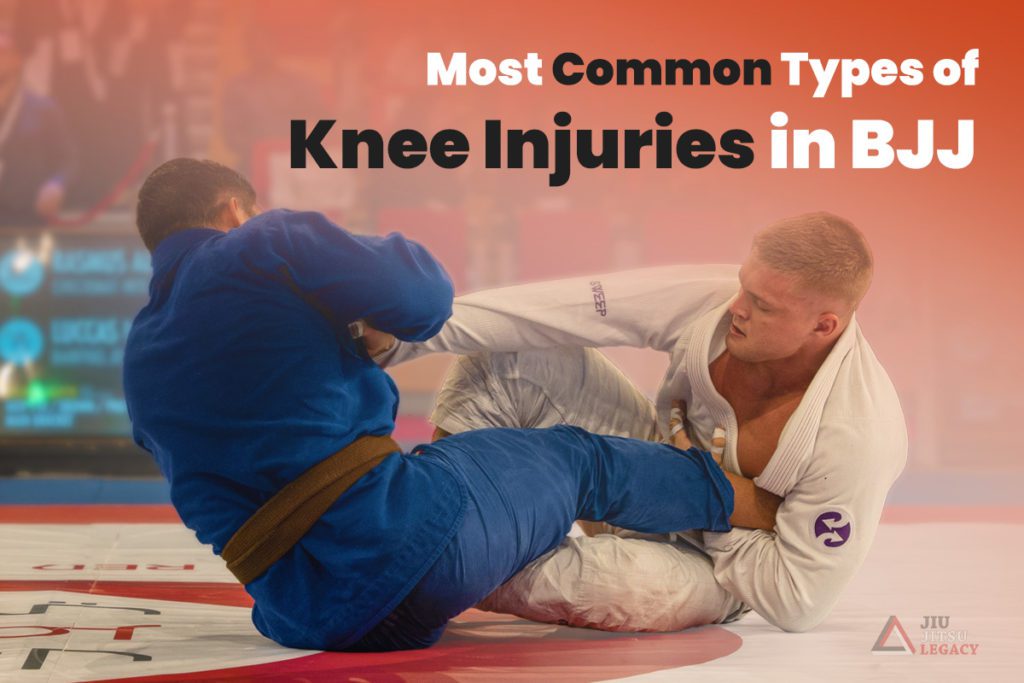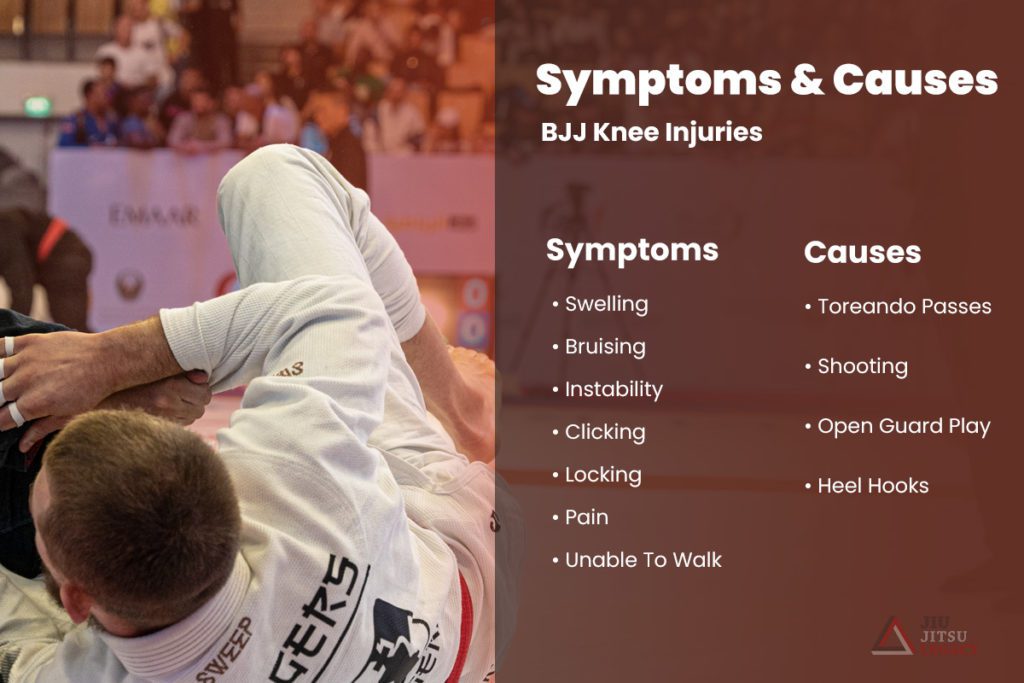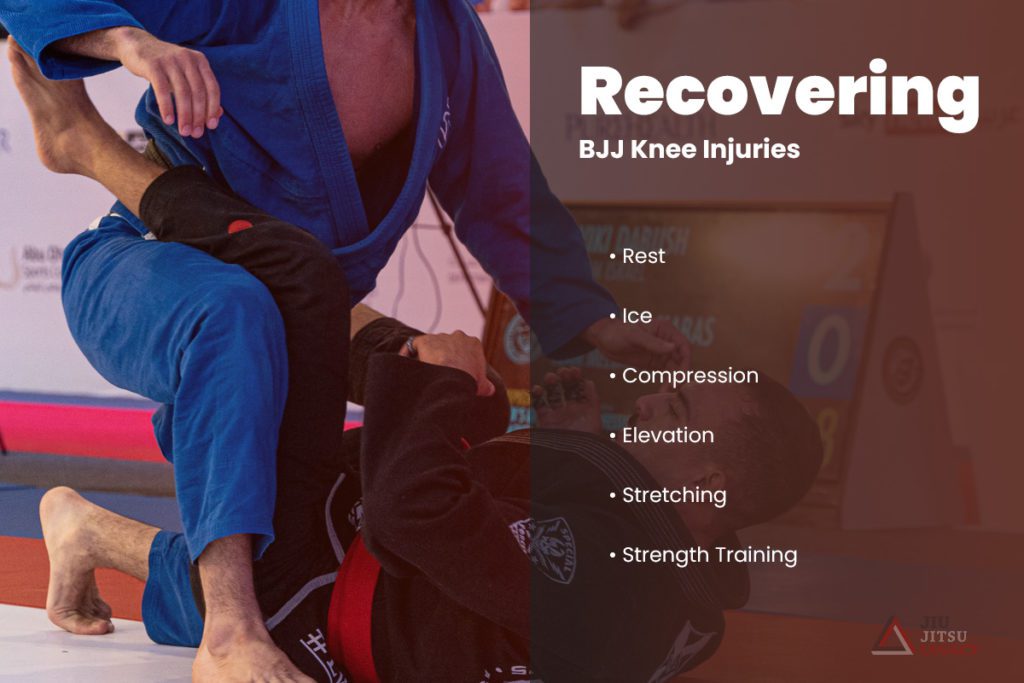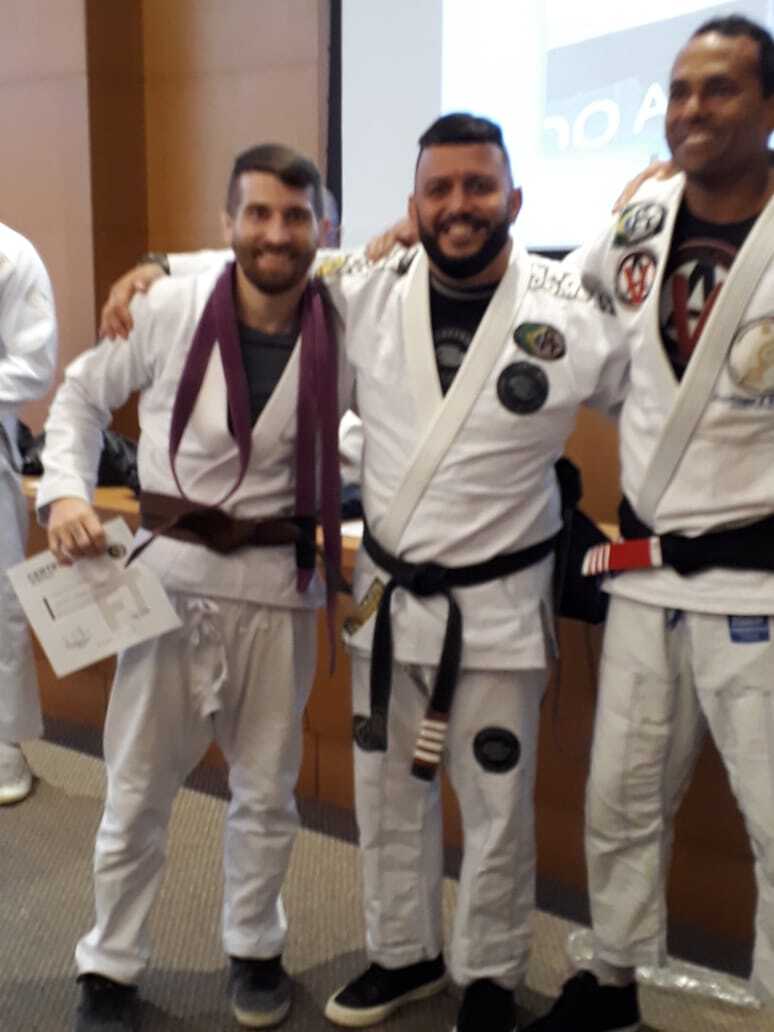Knee injuries are unfortunately a common part of BJJ training and something that you never want to go through. They can force you off the mat for long periods of time and may even end your jiu jitsu journey.
I know this from experience, and we’re going to talk all about knee injuries in BJJ. Read below about the most common injuries along with prevention and recovery protocols you must know.
Most Common Types of BJJ Knee Injuries

There are a wide variety of knee injuries in BJJ that you need to be aware of. Here are some of the most common types of injuries that occur in jiu jitsu.
Knee Sprains/Strains
The most common, less painful (but still awful) knee injuries in BJJ are sprains and strains. A knee strain is when the tendons in your knee are overly stretched due to a hyperextension or hyperflexion. It’s uncomfortable, but you won’t miss much mat time, if any.
Knee sprains are a bit more severe and are bit into grades 1-3.
- Grade 1 Sprain: Basically a more painful strain where a tendon is stretched beyond its limit, but remains intact.
- Grade 2 Sprain: A grade 2 sprain can result in a partial tear along with slight instability in your knee.
- Grade 3: A grade 3 is the most severe sprain that includes a tear in the fibers of a tendon. Your knee will feel completely unstable and probably will need therapy to rehab to 100%.
Bursitis
Another common, less severe knee injury in BJJ is bursitis. This is when one of the two bursa sacs in your knee is irritated. Possibly from impact or quick movement.
An injury like this could be temporary or chronic depending on if you continue irritating your bursa sack.
Dislocation
A bad movement in jiu jitsu could possibly even lead to a knee dislocation where your knee moves out of place. It’s extremely painful when your knee goes out until it’s put back in place.
Best case scenario, there was no structural damage, with only inflammation and instability that may need physical therapy. Worst case scenario is your tendons or nerves were damaged during the dislocation, which will take you off the mat indefinitely.
Meniscus Tears
Meniscus tears are one of the most annoying knee injuries in BJJ. The meniscus is the C-shaped cartilage that acts as the knee’s shock absorber.
Trying to train with a severe meniscus tear is nearly impossible, as when the nerves are irritated, your knee locks up. Limiting your movement and being in constant pain.
But the good news is if surgery takes less than an hour and your back training in 2 months.
Torn Ligaments
Torn tendons are the worst knee injuries that you can sustain in BJJ training. Your LCL, MCL, PCL, and of course your ACL being the worst one to tear.
Depending on the severity of the tear, you could miss anywhere from a few months to around a year. These injuries have ended jiu jitsu journeys for many BJJ practitioners.
Common Symptoms

The common symptoms of a knee injury are rather obvious. Common symptoms to look for in a knee injury include:
- Swelling
- Bruising
- Instability
- Clicking
- Locking
- Pain
- Unable To Walk
Causes of BJJ Knee Injuries
In jiu jitsu, you sometimes make dynamic movements that are unnatural to the human body. Moving with such force and at angles that puts intense pressure on your knees. Here are some of the main causes of knee injuries in BJJ.
Knee Cuts
Knee cuts are basic movements that can damage cartilage and tendons in your knees. A knee cut is a movement at a sharp angle used to pass an opponent’s guard.
When you do a knee cut, all the force of your movement is absorbed by your knee. If your knees aren’t conditioned for this quick movement, it can easily result in sustaining damage.
Toreando Passes
Toreando passes can do some damage to your knees with enough force. The movement is a powerful push and pull motion that puts immense pressure on your hips and knees. With enough pressure, one of these joints can give out and pop.
Shooting
Dropping your knee hard on the mat when shooting for a takedown can result in a knee injury. If you make the error of constantly dropping your knee to the mat when shooting, you’re likely to injure your knee.
Open Guard Play
Playing open guards like De La Riva, rubber guard, or a spider guard variation could lead to an injury. Especially if you don’t have flexible hips, as all the pressure will go right to your knees.
Heel Hooks
Then of course, there are the dreaded heel hooks that could damage your knees in less than a second. If you like playing the leg lock game, please be careful, learn the defenses, and tap early.
Can You Train BJJ with a Knee Injury?
Training with a knee injury will really depend on the severity of the injury. If it’s just a strain or bone bruise, you can probably grit it out if you go light.
But if there’s serious damage to your knee like a tear to your meniscus or tendons, training isn’t a smart idea. I know from experience, because I tried training with knee injuries, and they do more harm than good.
Prevention Against a BJJ Knee Injury
Knee injuries in BJJ are horrible to deal with, but you can take precautions to protect your knees. Here’s a list of all the precautions you can take to avoid knee injuries in BJJ.
- Stretching: One of the main causes of knee injuries in inflexibility in your knees and hips. Be sure to routinely go through stretches focusing on your hips, knees, and all of the muscles and tendons in between.
- Weight Training: On top of your BJJ training, you should consider taking up weight training with a focus on your legs. When your legs are strong, you lower the risk of knee injuries.
- Positional Awareness: Be mindful of the positions where you’re more likely to injure your knees. If you don’t put your knees in a bad position, you won’t injure them.
- Tap Early: Whenever you get caught in a leg lock that focuses on your knee, always tap early. It’s better to tap quickly rather than be sidelined with a damaged knee for months.
Recovering From a BJJ Knee Injury

When recovering from a knee injury, you have to be methodical about your recovery. Along with physical therapy, here are the steps you’ll need to take when recovering from a knee injury.
RICE
Remember the acronym RICE when dealing with a knee injury. Rest, ice, compression, and elevation constantly in order to return to training without missing too much time.
Stretching
After a knee injury, you will have to constantly make time for stretching every day before and after training. Using everything from bands and isolation stretches to improve the mobility of your knees and hips.
Strength Training
Strength training will be a must after an injury to restore the strength in your knee. Everything from calf raises, tibia raises, and leg lift variations must be done frequently to get back to 100%.
Changing Your BJJ Game to Protect Your Knees
If you sustain a serious BJJ game, it could alter the entire way you do jiu jitsu. That is why you may have to consider changing your BJJ game to protect your knees.
Changing your BJJ game can actually be very beneficial to your jiu jitsu game. Take the legend Roberto “Gordo” Correa.
In the late 1980s, Gordo sustained a severe knee injury that completely destroyed his ACL. Since ACL reconstruction had not yet developed, the surgeon basically told him he was done practicing jiu jitsu.
Gordo did not accept this and began figuring out ways around doing jiu jitsu with his bad knee. This led to him developing his half guard game that completely changed jiu jitsu.
Before Correa developed, attacking from half guard, being in the position just meant your guard was half-passed. But now, it has become one of the popular guards used in BJJ.
So, if you ever sustain a knee injury, just know there’s a silver lining. You may not be able to play your old BJJ game, but you can change it and be even more effective.
Knee Brace or Knee Pad Support
Knee Brace
A knee brace should be used post injury or surgery during your recovery process to ease back into training. They lock your knee in place and provide extra support for your injured knee.
If you’re just getting back into BJJ training after a knee injury, it is vital that you wear a knee brace. It will keep your knee protected as you try to get back to 100%.
Knee Pad/Sleeve
The knee sleeve is more used as a preventative against knee injuries, but also good to use if you tweak your knee. A knee pad/sleeve is a lighter piece of fabric that helps improve your range of motion. It does this by helping increase blood flow and keep your knee loose.
Summary
As a BJJ practitioner, a knee injury can be horrible to deal with, but it’s not the end of the world. You just need to focus on your recovery and take precautions to prevent this from happening in the future.
If you do this, you will come back stronger and be an even better grappler than you were before.

